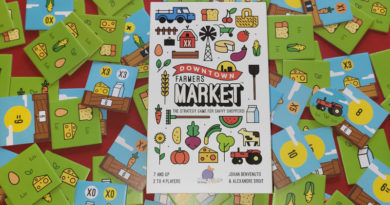Wolfenstein the Board Game preview
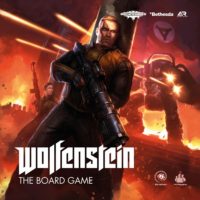
Who remembers the very first Wolfenstein video game in 1981?
I do.
Castle Wolfenstein was one of the first games I played on my Commodore 64. It was a stealth-based game where you’d try to avoid detection as long as possible. As you move around you attract the attention of the guards, making it harder to sneak around. You had to work through the levels of the castle to find secret plans and get out alive.
Since that first release, 12 more Wolfenstein games have been released. The original was shown from a top-down perspective with the characters upright. But that changed over the years as video game capabilities changed. As such, Wolfenstein 3D in 1992 was one of the first first-person shooter games.
And that’s where my playing ended (since we steer away from first-person shooter video games).
But the fun of the original game has stuck with me.
So when I heard about the upcoming release of Wolfenstein the Board Game, I was totally on board with checking it out.
And thanks to the folks at Archon Studio, I got my chance!
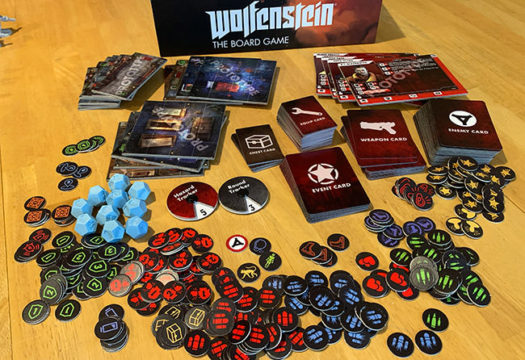
How to play Wolfenstein the Board Game
Wolfenstein the Board Game is a cooperative game where players work through various missions infiltrating the castle. They play as favorite characters from the video games – BJ Blazkowicz, Anya Oliwa, Set Roth, Max Hass, Klaus Kruetz and Bombate.
Each mission has its own, unique objectives and players must successfully complete each objective to win. Each mission will have the players exploring Castle Wolfenstein and fighting through the hordes of Nazis on their way to defeat the sinister plans of Adolf Hitler and his two cruel subordinates.
Because there’s so much going on in every game, I’m not going to give a detailed rundown on how to play. Instead, I’ll just cover the basics so you can get a feel for how the game plays.
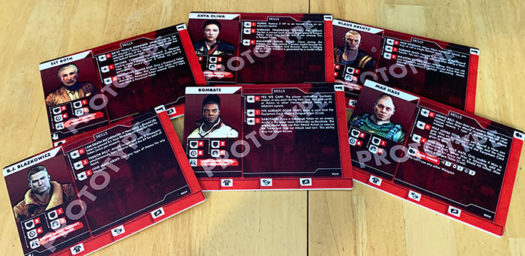
In addition to the rule book, the game comes with a Mission Book that outlines 10 unique missions for the players to play through.
After setting up the mission map and reading the objectives for that mission, players choose their hero characters. It’s recommended that even when playing with less than 4 players, choose 4 characters to attempt the mission. So some players may control more than 1 character.
Players take the character board of their characters and gather their starting weapons and equipment. Each character board outlines all the important statistics in the game such as skills, health, armor, action points, and more.
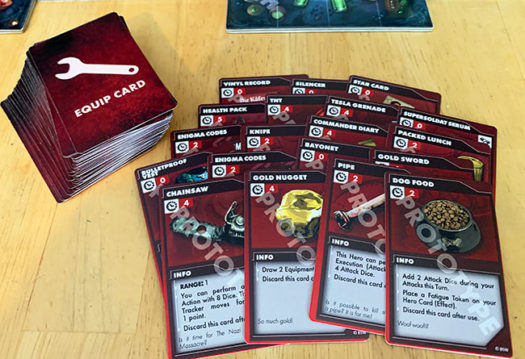
Each character will take turns activating before the enemy characters activate. When a character activates, they spend their Action Points to do various things such as moving, attacking, using equipment, searching, healing another hero, or removing barricades.
Some actions also require the use of 12-sided custom dice. For example, when a player Attacks they roll an amount of dice equal to their Accuracy value plus the Weapon Attack value. The dice results will show a Hit, Armor Hit, Reload or Blank and they’re resolved after the single roll (unless equipment abilities allow otherwise).
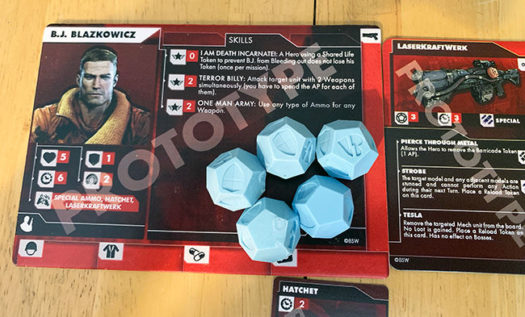
Players can also spend Glory points they’ve earned to undertake special abilities listed on their character boards.
In addition to the special abilities on character boards, each weapon characters can equip has unique special abilities that can be used by spending different amounts of collect ammo tokens.
After each character has activated, the Nazi enemy characters activate. When doing so, Nazi models only activate when they hear Noise, have been attacked, or a hero is in their line of sight.
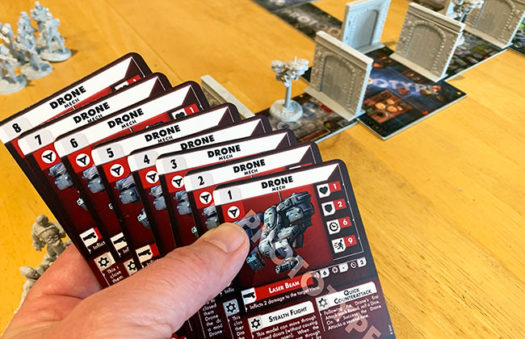
Since stealth is an important factor in the game, Noise triggers many enemy characters. Heroes mostly generate Noise when attacking. And Noise tokens are placed in rooms during hero turns so it’s easy to know which enemy models activate during the Nazi phase.
Each Nazi model type has a corresponding character card that lists its important stats and abilities. The cards also list an Initiative value that dictates the order in which the models activate. And of course, these enemies will take their toll on the heroes.
Players continue alternating hero and enemy activation phases until the heroes either successfully complete the mission or fail according to the mission rules.
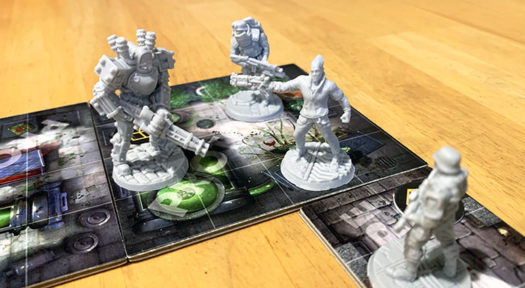
Can the whole family enjoy Wolfenstein the Board Game?
There’s a quick answer for this question that we start out in all our reviews. No. We don’t consider Wolfenstein the Board Game a family game. Nor do we think this is a game most of our readers will want to get.
But that doesn’t mean it’s not a good game. That just means the target audience for the game is different.
Instead, Wolfenstein the Board Game is targeted specifically at the same people attracted to the video game series. And that’s mostly going to be men and teen boys. Because of the theme and complexity, we’d give it a 14+ age recommendation.
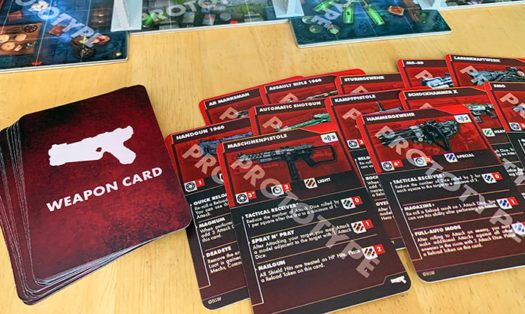
Diving into Wolfenstein the Board Game had us thinking a lot about one of the games our boys and I have loved playing over the years – Descent: Journeys in the Dark 2nd Edition. Because the general flow of the game is very similar.
In Descent, players take on the roles of heroes and complete various missions on a campaign against hordes of enemy monsters. Heroes gain equipment and special abilities that help them progress through the missions.
However, in the original Descent game, one player must control the Monsters and try to thwart the heroes. And it was typically, me (dad), going up against my hero sons.
But in Wolfenstein the Board Game, the enemies are automatically driven by the rules of the game. So it’s not one player against many. Instead, it’s a fully cooperative game. And that’s a great thing.
While it takes a little while to get the hang of the enemy-controlled models, by the end of the first mission, you’ll be rolling along. Just in time to add new enemies to face and figure out how to approach them the best.
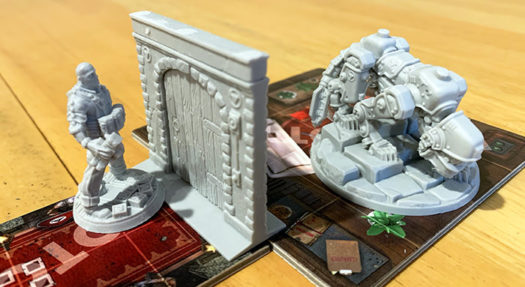
The variety of missions in Wolfenstein the Board Game is another great thing. While at first we thought having only 10 missions in the mission book would be limiting, it’s nice to see that they still offer a good variety of different challenges.
Plus, the game provides 4 difficulty levels to keep the game interesting for players. If you think a mission was too easy to complete, try it again on a higher difficulty level and see how you do. (We haven’t been so brave yet.)
We also can’t say enough about the awesome character models!
The detailed miniatures are extremely cool. And there are a ton of them!
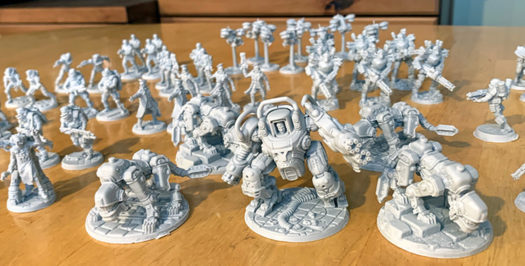
The models add a ton of flavor to the game. They’ll come at you from all angles and when you’re facing a larger foe, you’ll feel the pressure.
Another very cool level of detail are the doors blocking almost every section of the map in all the mission. These aren’t just slabs of plastic. Instead, they’re actual working doors that slide open!
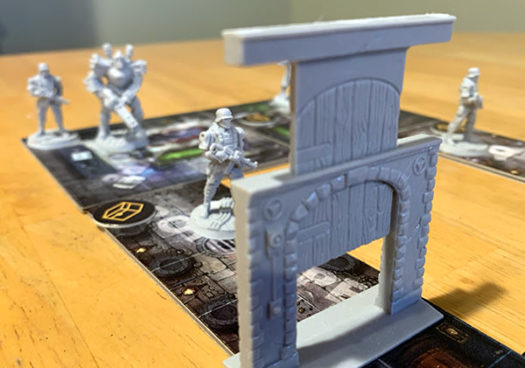
A few detractors to mention
The version of the game we received is still in prototype form. But Archon Studio has told us it’s very close to final. Yet, they’re still making changes based on feedback they continue to receive as they dive into the Kickstarter campaign.
With that in mind, we’ll mention a few of the drawbacks we’ve found with the game. We don’t know if any of these will be changed prior to final production, but to have a thorough review, we want to mention them.
All the map tiles are squares and rectangles of the same size. While this simplifies production and still allows for lots of different map layouts, we wish there was more variety in room shapes. Their flat edges also make set up quick, but because they don’t interlock, they can more easily be bumped and shifted during gameplay.
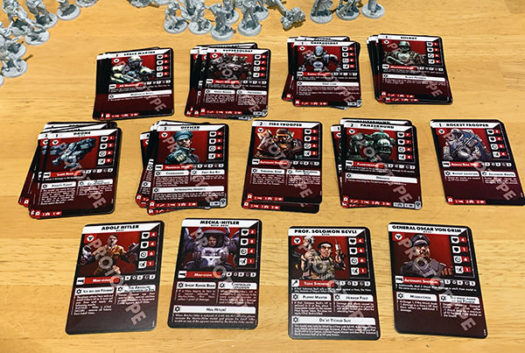
The overall color of red on all cards and boards is very fitting for the game theme. However, it also makes it more difficult to distinguish things when cards are all over the table. Yes, the enemy artwork is prominent on every card to show the difference. But during play, we wish there were bigger differences. Even having the hero boards be a different color than red would be nice because it truly is an us-vs-them type game. Yet the heroes boards and enemy cards are the same color.
Another difficulty we had was the size of the icons on the maps in the mission book. Each mission shows which enemy characters you’ll face and where to place them. However, the images are so small, it takes careful inspection to make sure you’re placing the correct enemy character models in the correct starting locations.
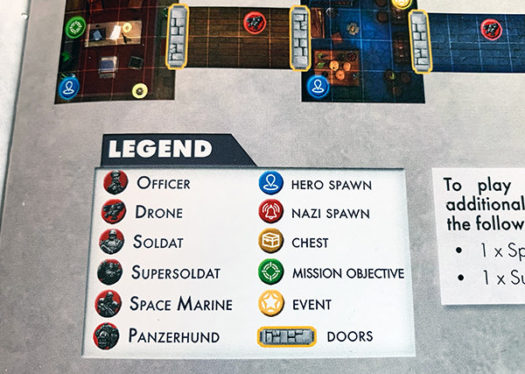
The last detractor we’ll mention is the size of the font on all the cards and character boards. It’s extremely small. Sure, they need to cram a lot of information on a card. But we find that we have to regularly pick up the cards to read the details of abilities. And that’s not always convenient during play.
How does Wolfenstein the Board Game score on our “Let’s Play Again” game meter?
With 10 missions to complete and 4 levels of difficulty, playing one game of Wolfenstein the Board Game isn’t enough. Perhaps it’s the completionist urge, but this is a game calling out for more plays.
The challenge though is that games take an hour and a half or more to play. Which means back-to-back plays are hard to make happen.
As we mentioned at the outset, Wolfenstein the Board Game is clearly targeted to appeal to those who enjoy the Wolfenstein video games. And for those fans, Wolfenstein the Board Game delivers an engaging adventure that feels very true to the original franchise.
Players will enjoy working together with their fellow heroes to infiltrate the castle, find secret plans, search crates for helpful gear, and eliminate their enemies all on their way to successfully completing increasingly harder missions.
If that describes you and your friends, then head over to the Kickstarter page to back Wolfenstein the Board Game to secure your copy of the game.




